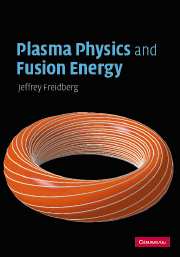Book contents
- Frontmatter
- Contents
- Preface
- Acknowledgements
- Units
- Part I Fusion power
- Part II The plasma physics of fusion energy
- 6 Overview of magnetic fusion
- 7 Definition of a fusion plasma
- 8 Single-particle motion in a plasma – guiding center theory
- 9 Single-particle motion – Coulomb collisions
- 10 A self-consistent two-fluid model
- 11 MHD – macroscopic equilibrium
- 12 MHD – macroscopic stability
- 13 Magnetic fusion concepts
- 14 Transport
- 15 Heating and current drive
- 16 The future of fusion research
- Appendix A Analytical derivation of 〈ς v〉
- Appendix B Radiation from an accelerating charge
- Appendix C Derivation of Boozer coordinates
- Appendix D Poynting's theorem
- Index
- References
7 - Definition of a fusion plasma
Published online by Cambridge University Press: 14 May 2010
- Frontmatter
- Contents
- Preface
- Acknowledgements
- Units
- Part I Fusion power
- Part II The plasma physics of fusion energy
- 6 Overview of magnetic fusion
- 7 Definition of a fusion plasma
- 8 Single-particle motion in a plasma – guiding center theory
- 9 Single-particle motion – Coulomb collisions
- 10 A self-consistent two-fluid model
- 11 MHD – macroscopic equilibrium
- 12 MHD – macroscopic stability
- 13 Magnetic fusion concepts
- 14 Transport
- 15 Heating and current drive
- 16 The future of fusion research
- Appendix A Analytical derivation of 〈ς v〉
- Appendix B Radiation from an accelerating charge
- Appendix C Derivation of Boozer coordinates
- Appendix D Poynting's theorem
- Index
- References
Summary
Introduction
In previous chapters a plasma has been defined qualitatively as an ionized gas whose behavior is dominated by collective effects and by possessing a very high electrical conductivity. The purpose of this chapter is to derive explicit criteria that allow one to quantify when this qualitative definition is valid. In particular, for a general plasma, not restricted to fusion applications, three basic parameters are derived: a characteristic length scale (the Debye length λD), a characteristic inverse time scale (the plasma frequency ωp), and a characteristic collisionality parameter (the “plasma parameter” ΛD). The sizes of these parameters allow one to distinguish whether certain partially or fully ionized gases are indeed plasmas, for example a thin beam of electrons, the ionosphere, the gas in a fluorescent light bulb, lightening, a welding arc, or especially a fusion “plasma.”
It is shown in this chapter that for an ionized gas to behave like a plasma there are two different types of criterion that must be satisfied. One type involves the macroscopic lengths and frequencies as compared to λD and ωP. The macroscopic length is defined as the typical geometric dimension of the ionized gas (L ∼ a ∼ R0), while the macroscopic frequency is defined as the inverse thermal transit time for a particle to move across the plasma (ωT ≡ vT/L). Plasma behavior requires a small Debye length λD 《 L and a high plasma frequency ωP 》 ωT.
- Type
- Chapter
- Information
- Plasma Physics and Fusion Energy , pp. 121 - 138Publisher: Cambridge University PressPrint publication year: 2007



